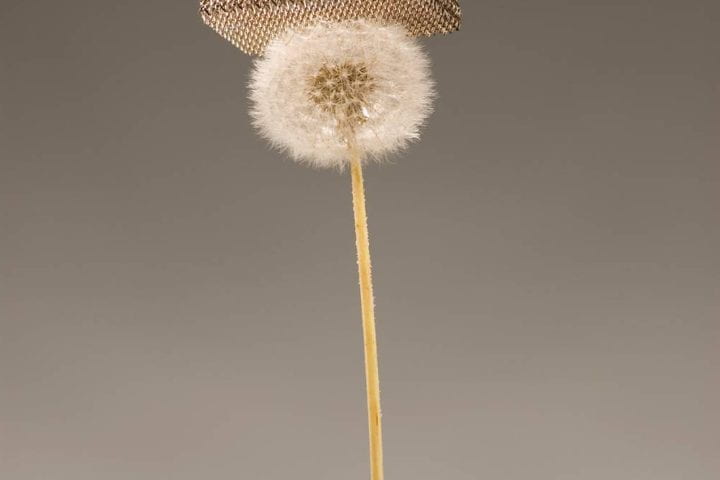Lighter than a feather and stronger than an ox
In collaboration with HRL Laboratories and California Institute of Technology, UCI engineers construct metal structure 100 times lighter than Styrofoam™.

Lorenzo Valdevit lifts a piece of metal clutched in his fist high in the air and drops it. Rather than plummeting to the ground, the chunk floats lazily to earth, light as a feather.
Lighter, actually.
Valdevit, assistant professor at the UC Irvine Henry Samueli School of Engineering, and his doctoral students Anna Torrents and Scott Godfrey helped develop this metal – the world’s lightest material – working with researchers from HRL Laboratories and the California Institute of Technology.
The new material is 99.99 percent air and is so light that it can sit atop dandelion fluff without harming it. At 0.9 mg/cc density, it’s approximately 100 times lighter than Styrofoam™.
Thanks to a unique lattice of hollow nickel tubes whose walls are 1,000 times thinner than a human hair, the material can also withstand damage. It can spring back completely from compression exceeding 50 percent strain. That’s quite a feat, considering that heaviness and strength are usually yoked in nature.
“This material gets stronger as the dimensions are reduced to the nanoscale,” says Valdevit, UCI’s principal investigator on the project. “You can decouple weight and strength, properties that are traditionally coupled.”
The novel material can be made quickly and cheaply, and could be used for battery electrodes and acoustic or shock energy absorption in both the automotive and aerospace industries.
“One of the main aspects of this processing technique compared to competing concepts is how remarkably inexpensive and scalable it is,” says Valedvit. “You could make really large parts very quickly. A couple of hours could give you a nearly finished product.”
The successful collaboration began when Malibu-based HRL researchers asked Valdevit and Julia Greer, a Caltech nanoscale specialist, to form a team and apply for federal funding allocated to innovative materials development. They won the grant and within a year, HRL, formerly Hughes Research Laboratory, sent UCI and Caltech a few samples, saying they believed they’d discovered the world’s lightest material.
With the manufacturing figured out, the researchers now face follow-up questions: How does the material behave and why? How can its architecture of struts and trusses be improved to maximize strength or other properties? It’s one thing to develop a light material, but to make it useful; it needs to be able to hold up.
“Our role is actually optimal design of these periodic architectures, and their mechanical characterization,” he says. “You want a unit cell that repeats, so that the material goes where you want it to. That’s really key.”
In short, the UCI group is coming up with the strongest possible structure for the material and testing it vigorously. Valdevit, Godfrey and Torrents use state-of-the-art equipment designed to stress items under loads up to 10 tons. They have installed special load cells to slowly compress the tiny pieces, measure their fortitude, and photograph points of impact and damage.
“The idea is to test how much the material can resist when you overload it,” Valdevit says. “We would try to make it as strong as possible, and Anna would squish it. The next two years are going to be about making it much stronger and stiffer.”
Torrents earned her doctorate last month based on the work.
William Carter, manager of the architected materials group at HRL, compared the new material to larger, more familiar edifices: “Modern buildings, exemplified by the Eiffel Tower or the Golden Gate Bridge, are incredibly light and weight-efficient by virtue of their architecture. We are revolutionizing lightweight materials by bringing this concept to the nano and micro scales.”
Funded by the Defense Advanced Research Projects Agency, UCI and its partners have a total of three years to develop and improve the material. In addition, the UCI team recently received a grant from the Office of Naval Research to devise variations that could withstand blast-force vibrations.
The research appeared in the Nov. 18 issue of Science, and attracted wide notice, partly thanks to an arresting HRL photo of the metal perched perkily atop a dandelion gone to seed.